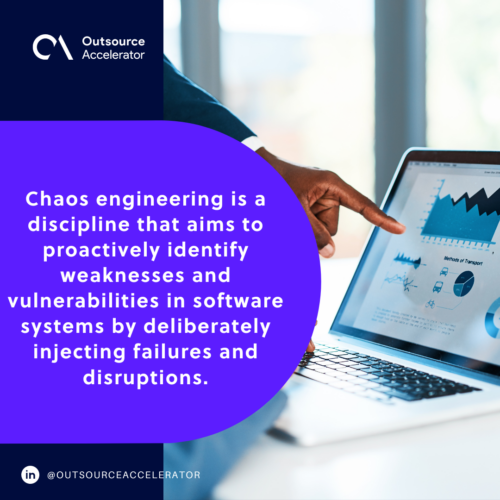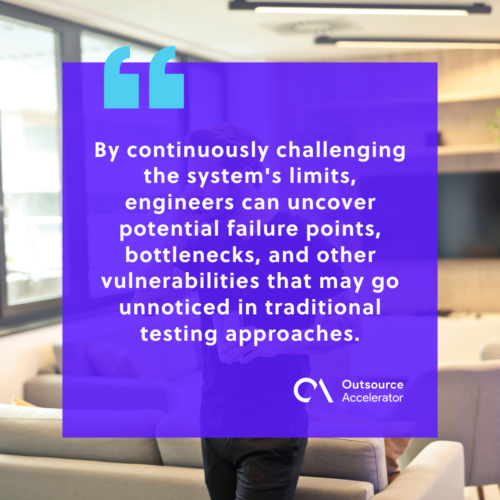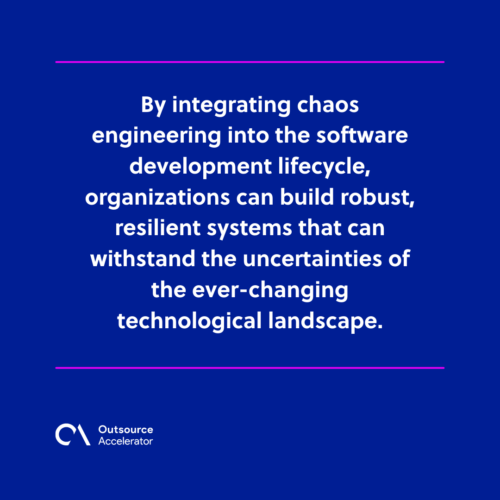Using chaos engineering to enhance software resilience

In today’s rapidly evolving world of software development, ensuring the resilience and reliability of systems has become paramount.
As software systems become more complex, ensuring they can withstand unexpected failures and disruptions is increasingly important.
One approach that has gained popularity in recent years is chaos engineering. This involves deliberately introducing failures into a system to test its resilience and identify potential weaknesses.
In this blog post, we will delve into the concept of chaos engineering, its principles, benefits, and how organizations can get started with implementing it.
What is chaos engineering?
Chaos engineering is a discipline that aims to proactively identify weaknesses and vulnerabilities in software systems by deliberately injecting failures and disruptions.
It involves running controlled experiments on a system to observe how it responds under turbulent conditions.
The goal is not to cause chaos indiscriminately but to gain insights into system behavior, improve resilience, and ensure a better customer experience.

The logic behind chaos engineering
At the heart of chaos engineering lies the belief that failures are inevitable in complex systems. By intentionally introducing controlled failures, chaos engineers seek to uncover weaknesses that may lead to catastrophic events in the future.
By systematically testing and challenging the system’s boundaries, engineers can gain a deeper understanding of its behavior and make informed decisions to enhance its resilience.
Principles of chaos engineering
Chaos engineering operates based on well-defined principles that guide its implementation. These principles include the following:
Hypothesis-driven experimentation
Chaos engineering involves formulating hypotheses about how a system should behave under different conditions and testing those hypotheses through carefully designed experiments.
This approach ensures that chaos engineering is not a random exercise but a methodical and goal-oriented process.
Steady-state
Before conducting any chaos experiments, it is crucial to establish a baseline or “steady state” of the system. This represents the normal, expected behavior of the system when it is functioning optimally.
By comparing the system’s behavior during chaos experiments with its steady state, engineers can identify anomalies and potential weaknesses.
Blast radius
Chaos engineering emphasizes the concept of “blast radius,” which refers to the scope and impact of a failure within the system.
By starting with small-scale experiments that target specific components, engineers can limit the potential damage caused by chaos experiments. They can gradually expand their scope as confidence in the system’s resilience grows.
Automated failure detection
Chaos engineering uses automated tools and monitoring systems to detect failures and anomalies during experiments.
Automated failure detection enables engineers to quickly identify issues, gather relevant data, and analyze the system’s response in real time.
Brief history of chaos engineering
Chaos engineering traces its roots back to the early 2000s when Netflix pioneered the practice as a means to improve the resilience of its streaming platform.
Netflix’s Chaos Monkey, a tool designed to simulate failures in production environments, became synonymous with chaos engineering.
Since then, chaos engineering has gained traction across various industries, with companies like Amazon, Google, and Microsoft incorporating it into their software development practices.
How chaos engineering benefits system development
Implementing chaos engineering brings several tangible benefits to system development:
Improved system resilience
By intentionally injecting failures and disruptions, chaos engineering enables organizations to identify and address vulnerabilities before they manifest under real-world conditions.
This iterative process leads to more robust and resilient systems that withstand unexpected events.
Proactive identification of weaknesses
Chaos engineering helps organizations shift from a reactive to a proactive approach in identifying weaknesses.
By continuously challenging the system’s limits, engineers can uncover potential failure points, bottlenecks, and other vulnerabilities that may go unnoticed in traditional testing approaches.

Enhanced customer experience
Resilient systems lead to better customer experiences. By conducting chaos experiments and addressing the weaknesses they reveal, organizations can:
- Reduce system downtime
- Mitigate service disruptions
- Deliver more reliable software to their users
Getting started with chaos engineering
To get started with chaos engineering, organizations should follow a structured approach:
Identifying critical system components
Begin by identifying the most critical components of your system. These are the areas where failures could have the most significant impact.
Focusing on these components allows you to prioritize your chaos engineering efforts effectively.
Setting realistic objectives
Clearly define what you hope to achieve through chaos engineering.
Whether it’s improving system resilience, identifying specific weaknesses, or enhancing customer experience, setting realistic objectives ensures that chaos engineering aligns with your overall goals.
Establishing a hypothesis
Develop hypotheses about how the system should behave under various failure scenarios. These hypotheses serve as the basis for designing chaos experiments and provide a framework for evaluating the system’s response.
Defining metrics and measuring the impact
Determine the metrics that will help you measure the impact of chaos experiments. These metrics could include response times, error rates, or any other relevant performance indicators.
By carefully measuring the impact, you can gauge the effectiveness of your chaos engineering efforts.
Choosing the right chaos engineering tools
There are several chaos engineering tools available that can assist you in implementing chaos experiments. Choose tools that align with your system’s technology stack and provide the necessary capabilities for simulating failures and monitoring system behavior.
Getting chaos engineering right
Organizations must adopt a culture of learning and experimentation to ensure the successful implementation of chaos engineering. It requires cross-functional collaboration, stakeholder buy-in, and a commitment to continuous improvement.
By integrating chaos engineering into the software development lifecycle, organizations can build robust, resilient systems that can withstand the uncertainties of the ever-changing technological landscape.

Chaos engineering provides a structured approach to enhancing software resilience by deliberately injecting failures and disruptions. By adhering to its principles, organizations can proactively identify weaknesses, improve system resilience, and deliver a superior customer experience.
Following a structured approach and leveraging the right tools, organizations can successfully implement chaos engineering. It allows them to build more reliable and resilient software systems in the future.







 Independent
Independent




